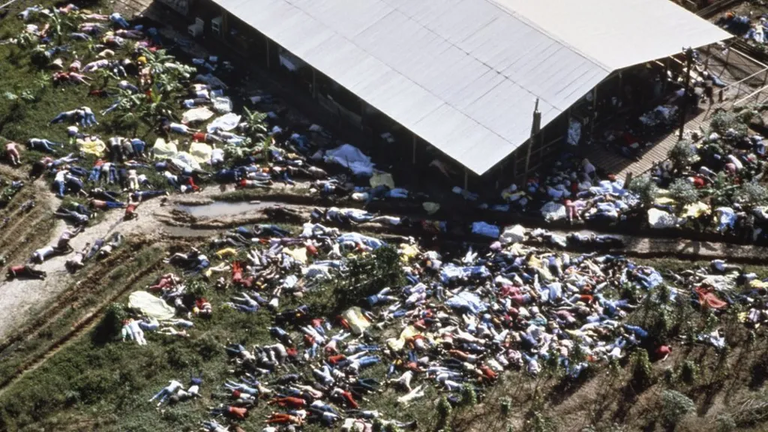One Man’s Dark Obsession That Claimed Over 900 Lives: The Jonestown Tragedy of 1978

In the dense forests of northwestern Guyana, far removed from the prying eyes of the world, a community arose—one that promised paradise, equality, and escape. It was called Jonestown.
The settlement was the creation of a man named Jim Jones, an American preacher with a voice that echoed promises of racial harmony, communal living, and spiritual salvation. He began his journey in Indiana, later moving his group—known as the Peoples Temple—to California during the 1960s. His followers, drawn by a vision of a just society, handed over their savings, their homes, and in many cases, their trust.
As scrutiny from the press and families grew, Jones sought to evade what he perceived as persecution. Guyana, with its remote terrain and political openness to outsiders, seemed a safe haven. And so, in the mid-1970s, hundreds of his followers boarded planes and buses, leaving behind their old lives for a promised utopia deep in the jungle.
Jonestown was built from scratch. Wooden cabins were erected, crops were planted, and loudspeakers broadcast Jones’s sermons day and night. Residents rose at dawn and labored until dusk. The atmosphere, at first optimistic, quickly became strained. Jones's speeches turned darker. He spoke of enemies—capitalists, governments, defectors. Armed guards began to patrol the compound. Letters were censored. Sleep was interrupted by rehearsals for mass death, drills he called "White Nights."
Despite the isolation, word began to spread. Families back in the U.S. feared for their loved ones. Defectors told harrowing stories. A congressman from California, Leo Ryan, took it upon himself to investigate. In November 1978, he arrived in Guyana with journalists and concerned relatives. They visited Jonestown. At first, things appeared normal—smiles, handshakes, a talent show. But during the visit, several residents passed notes pleading for rescue.
As Ryan prepared to leave with a group of defectors, the situation unraveled. On the airstrip near Port Kaituma, gunmen opened fire. The congressman, several journalists, and defectors were killed. Only a few escaped.

Back in Jonestown, the loudspeakers summoned the people. Jones addressed his flock. He told them the time had come. There was no future outside, only torture and death. Large vats filled with a sweet, poisoned liquid were brought out. Children were the first. Then the adults. Those who resisted were forced. Those who refused were shot.
By the next day, over 900 people lay dead. Cyanide had taken them. Many died believing they were serving a cause. Others died in fear or confusion. A few managed to flee into the jungle and survived to tell the tale.
The world awoke to images of bodies, massed together in bright clothing, silent among the trees. Jonestown became a symbol—not just of religious extremism, but of human vulnerability. It showed how hope, when twisted by control and fear, can lead to ruin.
In the aftermath, questions echoed for years. How could so many have followed? Why didn’t more escape? What allowed one man such sway?
Jonestown was never rebuilt. Nature slowly reclaimed the land. Trees grew where cabins once stood. Vines crept over the paths. But the story remained, retold again and again as a cautionary tale.
It reminds us that belief is powerful—and dangerous when placed in the hands of those who confuse leadership with control. And it reminds us to listen, not only to those who speak loudly, but to those whose quiet warnings go unheard.
https://www.reddit.com/r/ThatsInsane/comments/1l1zk7p/one_mans_dark_obsession_that_claimed_over_900/
This post has been shared on Reddit by @dkkfrodo through the HivePosh initiative.